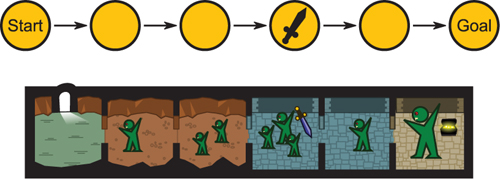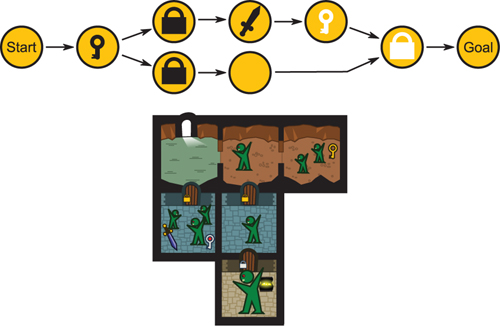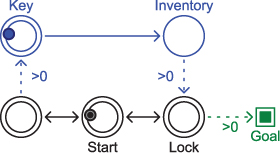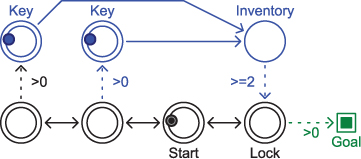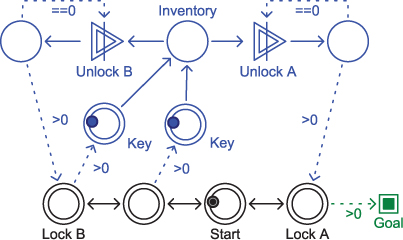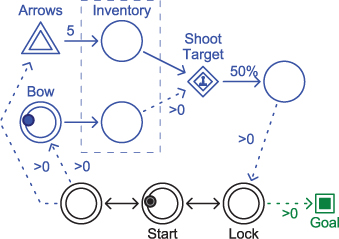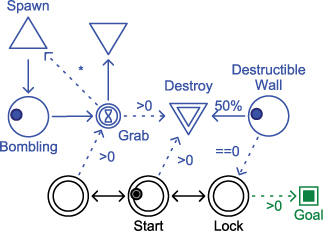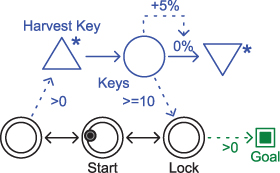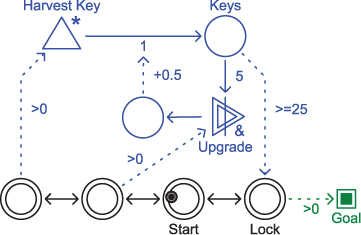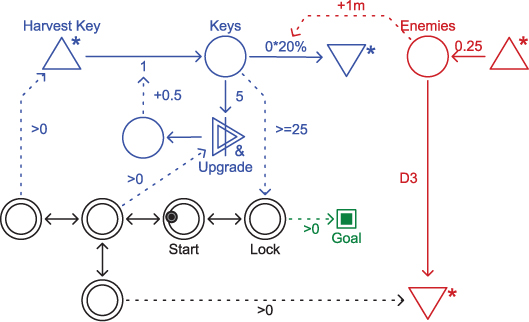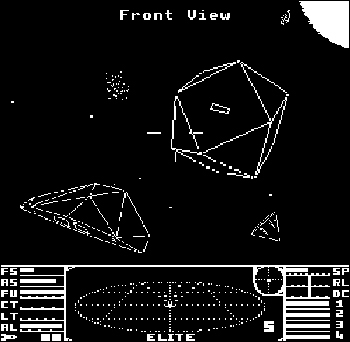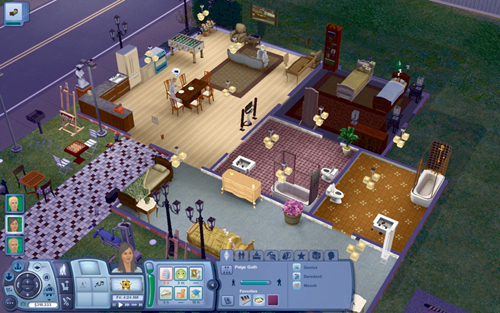Chapter 11. Progression Mechanisms
In Chapter 10, “Integrating Level Design and Mechanics,” we focused on the structural features of levels on a large scale. In this chapter, we examine the mechanisms that drive progression and that can be used to structure levels. We don’t restrict ourselves to the traditional mechanisms found in games of progression, but we look for ways to apply what we’ve learned from studying emergent gameplay to the mechanisms of progression.
Our goal is to find more emergent mechanisms of progression than commercial video games typically use, and we consider two different approaches. In the first half of this chapter, we investigate traditional lock-and-key mechanisms and identify ways to make them more dynamic. In the second half of the chapter, we abandon the conventional view of progression in terms of the player character’s movement through a level and toward a goal location, and instead we frame the notion of progression in more abstract terms: changing the state of the game toward a goal state. This perspective allows us to go beyond the common design strategies found in contemporary games and speculate about emergent progression, an approach that might bridge the gap between Jesper Juul’s games of progression and games of emergence.
Lock-and-Key Mechanisms
Games that feature many levels often rely on lock-and-key mechanisms to control the player’s progress through each level. In some cases, these mechanisms are described as actual locks and keys. For example, in Doom, the player can find a red, yellow, and blue keycard in most levels to open red, yellow, and blue doors. In The Legend of Zelda, Link typically uses small keys to open doors and needs to find the master key to unlock the door that leads the final boss of that level. However, we use the term lock-and-key mechanism to refer to any mechanism that controls access to parts of a level. In the original Adventure, a snake blocked the player’s path at one point (it was the lock), and it could be driven away only by releasing a bird from a cage (the key). The Legend of Zelda frequently uses other things that the player needs to collect as keys: the monkeys, bomblings, and the boomerang in the Forest Temple are all good examples.
General design wisdom dictates that it is usually preferable to have the player find the lock before he finds the key. There are three reasons for this:
• If the player generally encounters the keys before the locks, he develops the habit of collecting everything that he encounters without discrimination, just in case it might be a key that will be needed later. This makes for simplistic gameplay. When the player encounters a lock, rather than going to look for a suitable key, he tries everything in his inventory. Older adventure games tended to exhibit this weakness.
• When a lock (obstacle) doesn’t look like a real lock and its key (solution) doesn’t look like a real key, it is easier for the player to recognize the key if he has seen the lock first. Upon finding the key, the player usually can often guess its function and will actively formulate the intention to return to the lock. This makes the player’s role more active than simply reacting to whatever task the game throws at him. It is also more likely to make the player feel smart because he figured it out himself.
• When players can negotiate obstacles they were unable to get past earlier, they experience progress and accomplishment. There may have been obstacles he could not overcome, but he now has the power to do so. (You have to be careful not to frustrate your player too much, however; young children and casual players are less tolerant of obstructions than more experienced ones.)
It is not always possible to guarantee that the player will find the lock before the key; it depends on the topology of the space that he’s exploring. If the world is largely open and the player has the freedom to roam at will, then he may well find the key before the lock, although he may not recognize it as a key. We discuss lock-and-key mechanisms in the context of game spaces in the next section.
In our illustrations of game spaces in this chapter, the green objects are enemies, and the large one next to a treasure chest is a boss enemy. The player’s character is not visible but enters the level through the arched door from the outside. The colors of the keys match the colors of the locks they open.
Mapping Missions to Game Spaces
Lock-and-key mechanisms help the game designer to map missions onto spaces. (Remember that mission in this context refers to the collection of tasks required to complete a level.) As we saw in the previous chapter, game missions can be quite linear, especially in levels in which the player still is learning the basic mechanics of the game. At best, a mission allows a few alternative tasks for the player to work on. Again, the structure of the mission of the Forest Temple level (Figure 10.13) is a good example. In the most extreme case, a mission might be completely linear (Figure 11.1), but mapping such a mission to a physically linear game space is seldom the best option. Lock-and-key mechanisms allow a different way to map a linear mission to a nonlinear game space (Figure 11.2): It allows the designer to move the lock forward (closer to the level’s entry point). In theory, it also allows the designer to move the lock backward, but because, as we already argued, it is better to have the lock before the key, moving the lock forward makes the most sense.
Figure 11.1. Mapping a linear mission to a linear game space. Note that acquiring the sword will help defeat the big boss at the end.
Figure 11.2. Using locks and keys to map a linear mission to a nonlinear game space
Despite the addition, the solution to the level in Figure 11.2 is still always the same. Any player playing it must perform the same tasks in the same order. To create more variation and provide the player with a choice to make, many games use multiple keys to unlock a single door (Figure 11.3). The monkeys in the Forest Temple offer a good example of that construction.
Figure 11.3. Using multiple keys to unlock a single door
We can also do the converse and give the player a single key to unlock multiple doors. The boomerang in the Forest Temple serves this purpose. Unfortunately, it cannot be used to reorder the game space directly, because this potentially cuts the level short and creates a problem for the player (Figure 11.4). The trick to create multiple locks for a single key, and still place those locks before the key, is to add extra lock-and-key mechanisms (Figure 11.5) or to mirror the multiple locks mechanism with a multiple keys mechanism (Figure 11.6).
Figure 11.4. Poor use of a single key that opens multiple locks: The player might encounter the boss before she finds the sword.
Figure 11.5. Combining multiple locks for a single key with an additional lock-and-key mechanism
Figure 11.6. Multiple locks for a single key with multiple keys for a single lock
Using Abilities as Keys
Lock-and-key mechanisms are more common in games than actual locks and keys; most lock-and-key mechanisms are characterized as something else, such as switches or a permanent power-up that allows the player to smash down particular doors. It is a common game design strategy to control a player’s progress by granting her permanent abilities that act as keys. For example, in a platform game, gaining the ability to double jump allows the player to cross wider gaps and reach higher platforms than before. Devising clever lock-and-key mechanisms that are closely integrated to the core gameplay is an important aspect of the level designer’s job. Because gameplay is created by mechanics, you must invent locks and keys that are based upon, or interact with, the game’s core mechanics. For example, if the game is about jumping, special jumping abilities should function as keys. If it is a game about sword fighting, you should look for ways to create keys for special sword fighting abilities, and so on.
One difficulty with using permanent abilities as keys is that it creates a single key used for multiple locks. As we explained in the previous section, that type of construction isn’t always easy to use. If you want the player to encounter a number of locks before finding the key, you have to be careful that you don’t accidentally create a lot of unintended shortcuts. At the same time, the player needs to be able to clearly see that an area is locked (rather than just difficult to access). One way to create many locks that the player passes on her way to the key is to have these locks lead to bonus tasks and rewards that do not affect the game too much, but just enough to feel rewarding to exploration-minded players.
Creating key mechanisms from player abilities, rather than from game world objects, also has advantages. You can combine these actions in interesting ways with each other and with other elements in the game. For example, a double jump might be the key to cross a wide gap, or to avoid creatures that are too tall to jump over with a single jump. Being able to identify possible combinations of mechanisms in the game that you can use to create locks and keys to structure your levels is a very useful skill. It allows you to get the most out of a game’s mechanics and lets you to create varied gameplay efficiently.
Lock-and-Key Machinations
In Chapter 6, “Common Mechanisms,” we showed you how you can use Machinations diagrams to represent lock-and-key mechanisms: A key mechanism often is a simple state change that unlocks new areas in the game space. Its essential structure is represented by Figure 11.7.
Figure 11.7. A simple lock-and-key mechanism (blue) to control progression through a space (black)
This structure has a weakness, however. The game can be in only one of two states: Either the player has the key or he doesn’t have it. There is little room for dynamic behavior. The Machinations diagram reveals that simplicity. The mechanism is built from two pools and based on a resource (the key) that can move in only one direction (into the inventory). One consequence of this is that the player can never put the key down. Many games implement this system deliberately so that the player can never accidentally leave a critical key behind—The Longest Journey is a well-known example.
Even if we look at typical variations found on locks and keys, the mechanics do not get much more complex or dynamic. A few examples include nested locks, such as when a nonplayer character requires the player to undertake several quests before providing a key; multiple keys for a single lock (Figure 11.8); or keys that are consumed when they open a door (such as the mysteriously disappearing small keys in The Legend of Zelda, as in Figure 11.9). Note that in the case of a consumable key, the player might be forced to choose between two directions because she cannot unlock both doors with a single key. In the case of Figure 11.9, the “level” will always be solvable because behind lock B, there is another key, and once a door is unlocked, the player cannot “spend” a key to unlock it again.
Figure 11.8. A lock requiring multiple keys to open
Figure 11.9. Keys that are consumed upon use
If we want to involve player skill, rather than simply the presence or absence of a player ability, we need a different mechanism. In games like Fallout 3 and The Elder Scrolls: Skyrim, the player uses lockpicks to try to open locks. There is a chance the lockpick will break, and the player will fail. In these games, the chance of failure depends on the skills of the player and the attributes of his character. Lockpicks are a consumable resource, and if it is vital that the player get past a certain lock in this manner, the game must ensure that she has an unlimited source of lockpicks. Figure 11.10 represents this type of lock-and-key mechanism.
Figure 11.10. Skill-based lock-and-key mechanism
In The Legend of Zelda, the bow and arrow can be used to open doors by shooting distant switches. The mechanism (Figure 11.11) combines a skill-based lock with a more traditional lock-and-key mechanism: The player must have the bow and at least one arrow. Using the lock consumes arrows (and has a chance of failing). As with the lockpicks in the previous example, the game must include some sort of mechanism to supply the player with enough arrows to prevent creating a situation in which he cannot proceed.
Figure 11.11. The bow and arrow in Zelda combines a regular key (the bow) and a consumable skill key (the arrows) mechanism.
This type of lock does not display dynamic behavior; it contains no feedback loops. Even more elaborate game mechanics for locks and keys, such as the bombling creatures in Zelda (Figure 11.12), create more interesting gameplay, but they typically do not create the dynamic behavior we are looking for.
Figure 11.12. Bombling keys. Try this in the Machinations tool.
Throughout this book, we have stressed the importance of feedback loops in the creation of emergent gameplay. You might have noticed that so far, the lock-and-key mechanisms discussed in this section include little feedback. The activators in Figure 11.9 create some feedback, as does the trigger to spawn a new bombling in Figure 11.12. However, in both cases this feedback is very local and does not affect the lock-and-key mechanics much.
Dynamic Locks and Keys
To create lock-and-key mechanisms that involve more feedback, start by treating the keys as a resource that can be produced and consumed, rather than as a simple item that either is or is not in the player’s inventory. For example, Figure 11.13 represents a mechanism in which the player needs to harvest ten keys before she can open the lock. (In this case, harvesting is an automatic action that happens when the player is in the right location.) Feedback takes place through the application of dynamic friction on the number of keys the player has collected. The more keys that are harvested, the quicker the keys are drained. In this case, we might think of the key as a kind of magical energy the player needs to unlock a door. This mechanism makes it somewhat harder to estimate how many keys need to be harvested to get past the lock. Obviously, this gets even more difficult as the distance between the location where keys can be harvested and the lock increases. Unfortunately, the mechanism is not very interesting in itself: It boils down to harvesting enough keys and then dashing for the door. There is little strategy involved. But we can improve on it.
Figure 11.13. A simple feedback mechanism for a lock-and-key mechanism
We can create a more interesting mechanism by applying the dynamic engine pattern to the mechanism. Figure 11.14 represents such a mechanism. This time, the player needs to collect 25 or more keys to proceed, but now she has the option to invest 5 keys to increase the harvest rate by 0.5. However, this mechanism is probably too simple. It is not very difficult to find out what number of upgrades is ideal for this scenario (which also depends on the speed with which the player can move between the different locations in the game). Worse, a disadvantage of this mechanism is that it is optional: The player can reach the goal without upgrading at all. These weaknesses should not come as a surprise: As we argued in Chapter 6, one feedback loop alone is generally not enough to create an interesting dynamic mechanism.
Figure 11.14. Applying the dynamic engine pattern to the mechanism
If this idea of dynamically generated keys seems strange to you, remember that we don’t necessarily mean physical keys for physical locks in physical doors. Many construction and management simulations require players to master part of their economy to unlock new buildings or other features. A role-playing game could use such a system as the key to solving a quest: The blacksmith will reward you if you can take over his business and make it profitable.
The emergence of a dominant strategy in the form of an ideal number of upgrades is the direct result of the dynamic engine pattern. We have seen similar patterns already in our discussions of Monopoly and the Harvester game. Games that mostly rely on a dynamic engine as their sole, or single most important, feedback loop, as is the case with Monopoly, usually include random factors to make it more interesting and unpredictable. That would be an option, but it is not the direction we want to explore here.
To create a more interesting lock-and-key mechanism, we can complement the dynamic engine pattern by some form of dynamic friction (Figure 11.15). In this case, enemies spawn that will steal and consume the harvested keys from the player. Now the player has to balance between three tasks: harvesting, upgrading, and fighting the enemies, whose numbers increase over time unless the player destroys them. This is no longer a trivial challenge; beating the interactive version of the Machinations diagram is already fairly tough and less straightforward than it looks. Simply harvesting will probably not bring the player very far, and although it is possible to achieve the goal by switching between harvesting and fighting, this requires the player to maintain a delicate rhythm of switching between the two for a long time; it is very hard to accomplish. The player needs to find a balance between the three actions to reach the goal. When the fighting is made skill-based, then the most effective balance can actually vary depending on the individual player’s level of skill.
Figure 11.15. A multiple feedback mechanism for locks and keys
The lock-and-key mechanism we have now leads to a gameplay that is very similar to the gameplay of a real-time strategy game: Players must balance between harvesting raw materials, fighting, and upgrading their units to keep the enemies under control and make the final push to complete the game. The combination of a dynamic engine and some form of dynamic friction is the heart of most real-time strategy games. For a multiplayer game, you might replace dynamic friction with attrition (another form of friction) and add an arms race pattern to introduce more base-building options.
Structuring Levels Around Dynamic Locks and Keys
Level design that is built on relatively simple and nondynamic lock-and-key mechanisms has to string many of these mechanics together. The big advantage of dynamic lock-and-key mechanisms is that one or two of them can serve as the backbone of a level; you don’t need as many mechanisms to create a compelling and lasting gameplay experience. You can already notice this from playing around with the diagram in Figure 11.15. Simply getting past its single lock will take a lot of actions and considerably more time than most simple locks. More importantly, the choice of actions available offers more freedom and requires more strategy from the player to solve than a nondynamic lock-and-key mechanism that simply hides many keys for a single lock in a maze, even though the actions that the player performs (navigating through a maze) are almost the same.
You don’t always have to create the dynamic lock-and-key mechanism for each single level to structure a level around it. If the game you are working on already has dynamic core mechanics, it makes sense to look at those mechanics first. Perhaps there are already structures in them that would function perfectly as a dynamic lock-and-key mechanism. If there are, it allows you to create levels efficiently, because you don’t have to add extra mechanics to create locks and keys (assuming you want them), and you can keep the game focused on the core mechanics. In other cases, a few simple additions or changes do the trick. In those cases, you could add different mechanics to the core to create different levels. When done right, this creates games with variations in their gameplay and in which each level has its own unique feel.
Another advantage of using dynamic lock-and-key mechanisms to control progression, rather than simple static ones, is that you can change the difficulty of the challenge by adjusting the numbers in the mechanism. One of the weaknesses of simple lock-and-key adventure games is that it’s almost impossible to offer the player a choice of difficulty levels because the relationships in the game are purely binary: Either the player has the key or he doesn’t. A dynamic system is adjustable.
Structuring levels around a single lock-and-key mechanism is more common than you might think. It works even for lock-and-key mechanisms that are not so dynamic at all. For example, the level structure of dungeons in The Legend of Zelda is built around the weapon you win from the midlevel mini-boss and the way it functions as a key to several doors. Most levels simply add one mechanism that requires the player to collect multiple keys. Of course, lock-and-key mechanisms are not the only form of challenge found in these levels, but they do play an important role in creating the right structure of progression for the level. This combination of mental and physical challenges creates the excellent gameplay experience of being a heroic adventurer.
Emergent Progression
In many games of progression, the goal of the game is to reach a certain location (and perhaps to perform an action there). Progress in these games is mapped to the game space; the game is a journey. Figure 11.16 represents this type of progress in its simplest form. The game informs the player of his progress, either directly with a measure of distance traveled or indirectly by exposing the player to novel and interesting locations. In designing a game that maps progress to space, lock-and-key mechanisms are the most important tool you have to structure the gameplay experience.
Figure 11.16. Progress as a journey
However, there are more ways to look at progress in games. In the previous chapter, we described progress in terms of how close the player is to reaching a victory condition. In this case, progress is not measured as space traversed but in terms of some aspect of the game’s state. It can be convenient to think about how many actions the player needs to perform or how much time he needs to bring about the target state. Figure 11.17 represents this structure in its most elementary form.
Figure 11.17. Progress as an aspect of the game’s state
Framing progress as a relationship to a particular game state allows us to think about creating dynamic forms of progress from new angles.
Progress as a Resource
To measure progress in terms of the game’s state rather than in terms of the player’s location, it’s best to treat progress as a resource in its own right. This offers you many more opportunities to create interactions between the player’s progress and other mechanics in the game. Experience points and character levels are classic examples from role-playing games; they’re numbers that not only tell the player how he’s doing but also can be used for internal computations. (Many RPGs include weapons that are available only to characters above a certain level, for example.)
Most role-playing games don’t let their players trade or otherwise manipulate experience points, but experience points are absolutely central to the game, figuring in all sorts of calculations—they are simply a resource that the player cannot directly modify. If the idea of progress as a resource seems strange, think of it in terms of experience points. (Depending on the game, they need not be visible to the player.)
You can let players trade their progress points away for some long-term benefit that will help them progress faster. If the object of a game is to be the first to earn a stated amount of money, smart players might invest their money (thus apparently losing progress) in schemes that will earn new money faster. You can also use a player’s progress to vary the difficulty of the game’s challenges as she plays. This is exactly the way Space Invaders works: The speed at which the aliens move in a given wave is proportional to the number the player has already shot. The more the player kills, the faster they move and the harder they become to kill. Their speed also increases from wave to wave.
Games that measure progress in terms of travel through space have to rely on careful placement and ordering of the game’s challenges to create an appropriate difficulty curve, and it will usually be the same every time the player plays the game. Determining progress from the state of the game allows the mechanics to adjust the difficulty automatically and to offer a different experience on each play-through. You can also use the slow cycle design pattern to create oscillating degrees of difficulty throughout the level.
Producing Progress Indirectly
We can take the idea of progress as a resource one step further by having the players produce progress indirectly and measure progress over multiple resources. In this case, there isn’t one particular action that produces progress. Instead, the process to produce progress involves multiple steps and multiple resources.
This approach is common in open-ended simulation games. For example, in the space trading classic Elite (Figure 11.18), players fly space ships to trade across a vast galaxy. It inspired many space trading games such as the Privateer series and the MMO Eve Online. Most of the money the player earns will be invested back into her ship. A better ship allows the player to travel farther and into more dangerous, but also more lucrative, quadrants of space. The player’s progress in the game is measured by the quality and capacity of her ship—a collection of concrete resources. Although the open-ended nature of the game permits players to choose their own goals, acquiring a powerful space ship and amassing wealth seems to be a common target for most players.
Figure 11.18. Elite
In Elite, it is also possible to lose progress: The player’s ship may be attacked and destroyed, the player can fire precious missiles to fight off pirates, or the player might use an expensive one-time intergalactic hyperdrive. Losing progress in this way is fairly uncommon in games in which progress is represented as a journey, but it’s entirely normal in simulation games.
Another good example can be found in the board game The Settlers of Catan (Figure 11.19). The objective of this game is to score ten points. Points are scored for building villages, upgrading villages to cities, building the longest road, playing the most knights, or being lucky in the purchase of development cards. All these point-scoring mechanics are interrelated. The player can’t simply build a new village and get a point any time he wants; he must build roads to suitable locations and acquire the right set of resources. Building a village isn’t the endpoint of the process, either. It increases the player’s chance to gain new resources, while upgrading a village to a city increases its resource output.
Photo courtesy of Alexandre Duret-Lutz under a Creative Commons (CC BY-SA 2.0) attribution license.
Figure 11.19. The Settlers of Catan with the Seafarers extension.
Figure 11.20 represents most of the economy of The Settlers of Catan, though certain mechanics, such as the extra points scored by building the longest road and by playing the most knights, have been omitted. Figure 11.20 is turn-based and uses color-coding to distinguish among the five resources in the game. The production mechanism reflects the fact that both cities and villages generate a chance to produce a resource every turn, while every city increases the chance that the production rate is doubled. We advise you to play around with the online version of the diagram to fully grasp the way the game’s internal economy works.
Figure 11.20. The economy of The Settlers of Catan
The economy of The Settlers of Catan is dominated by a dynamic engine that is also subjected to a engine building pattern and that interacts with a trade pattern. The game manages to avoid the typical gameplay signature associated with a dynamic engine by creating several options to invest and by having all these investments add to the game’s progress. The simple accumulation of resources is not the point of the game. Another side effect of using an indirect measure of progress is that it’s not trivial for players to accurately read the state of the game. Although it’s fairly easy to see how many cities, villages, and resources each player has, because of the indirect way that points are computed, it’s hard to guess who is actually closest to winning, especially because the number of available building sites is limited. A player might need just one extra village to score the extra point, but if all building locations have been taken by other players, it will be impossible. The player will need many ore and wheat resources to build a city, and those resources might not be easy to come by. So, even though he seems to be close to victory, he might be far from reaching it. Also, the nature (but not the number) of each player’s trade goods is hidden, and the dynamic engine relies on a random mechanism, which further complicates trying to assess who’s ahead. By comparison, it’s obvious in Monopoly, because all the players’ possessions are in plain view.
Because The Settlers of Catan measures progress indirectly, it is possible to win in more than one way. Players might go for many villages and cities or, alternatively, bet on getting the right development cards. The first option is a fairly safe choice but requires many resources, while the cards become a good option when the player has fewer resources; it represents something of a high-risk, high-reward strategy.
Many people have criticized The Sims for its relentlessly materialistic approach. Your sims have no spiritual life and seem not to be able to derive happiness from anything but extravagant furnishings. A close reading of the tongue-in-cheek descriptions of the furniture in the game shows that the developers were perfectly well aware of what they were doing. The game is a satire.
The Sims also measures indirect progress over many different resources. The player takes control of a number of sims: simulated people who live in something that is best described as a virtual dollhouse (Figure 11.21). The player’s success is measured in terms of the material goods (furniture and features of the house) that the player accumulates for his sims but also by the advancement of the sims’ professional careers. The Sims is a time-management game in which the player must use the limited time available to perform all the activities necessary to keep them happy and healthy. By taking good care of his sims, they will find jobs. If they make it to work on time and in good health and good spirits, they will advance their careers. Better jobs means they will bring home more money that the player can spend on items to entertain the sims and to make their daily routine run more efficiently. Although the game does not state that the goal is to guide the sims toward material and professional success, it is implicit in the mechanics, and many players play it that way.
Figure 11.21. The Sims 3 in a mode showing the furnishings and elements of the economy in the overlay at the bottom
Emergent Progress and Gameplay Phases
One of the jobs of traditional, nonemergent level design is to create varied, well-paced gameplay. When progress is measured by movement through space, the level designer’s ability to craft that space gives him a lot of control over this aspect of the game. But when progress is an emergent property of the dynamic system formed by the game mechanics, this type of direct control over the gameplay becomes impossible. However, that is not to say that games with emergent progression cannot have varied and well-paced gameplay. It only means that pacing and variation need to be created differently.
In games of emergence, variation and pacing have to come from different phases that the game goes through. In this case, a gameplay phase is a period of time in which the dynamic behavior of the game follows a certain pattern. When a significant shift in the dynamic behavior occurs, the game progresses to a new phase. For example, in a typical real-time-strategy game, the initial phase is dominated by resource harvesting and base building. The player quickly accumulates resources and invests in defensive buildings and units. At a certain point, the player’s behavior will change: He will start building an offensive force to explore the map. During this phase, the focus is more on capturing strategic points on the map and perhaps on securing access to future resources. Once the player has accumulated enough resources and has found the location of the enemy base, he will probably launch a massive attack to try to overcome his opponent.
Figure 11.22 maps these phases to distinct patterns in the resources and production rate of the player. The chart shows that during each phase the changes to the state of the game follow a particular pattern that is relatively stable. During the building phase, the player spends his resources fast, while his production rate grows quickly. During the exploration phase his resources accumulate because his focus is on a different aspect of the game. During the offensive phase, the number of resources go up and down as the player switches between building and launching attack waves.
Figure 11.22. Charting phases in an RTS game
These three phases do not have to occur in the game, and when they do occur, they might occur in a different order. The rushing strategy (see the section “Balancing SimWar” in Chapter 8, “Simulating and Balancing Games”) partly depends on executing a very short building phase and then skipping the exploration phase and going on the offensive immediately. There are also other possible phases. For example, a level that requires that the player capture and use resources spread around the landscape might have consolidation phases that are mixed in between different exploration phases. If there are multiple enemy bases, the first offensive phase is probably followed by a similar consolidation phase. Games that emphasize technology tree mechanics probably have a research phase, a period during which neither offensive activity nor construction takes place, but players invest resources to upgrade their units and production buildings.
Composing Gameplay Phases
When you are designing levels for a game that has a number of these emergent gameplay phases, your job is to compose a desired gameplay experience from them. Suppose that, in our real-time strategy game, your design goal for a particular level is to emphasize the first building phase. You can achieve this by harassing the player early on with small groups of enemies that attack frequently. This forces the player to maintain a delicate balance between increasing production and building up defenses, and it slows down the former considerably. The effect will be that the building phase will probably be much longer. By creating a map in which resources are relatively scarce and scattered, the player is more likely to go through several exploration and consolidation phases.
It often requires a major event to initiate a shift between gameplay phases. While a game is in a particular phase, it is in balance, and the player probably settles into a certain rhythm of play. We have identified several design patterns that are commonly used to create significant events that can cause the game to shift to a new phase.
• Slow cycle. In the previous chapter, we discussed the slow cycle pattern in StarCraft II to shift the game between distinct defensive and offensive phases. In general, a slow cycle is effective but also a little lacking in subtlety, especially when the player has little impact on the slow cycle mechanism. (According to legend, King Canute demonstrated the limits of monarchical power by showing that he could not hold back the tide, a classic slow cycle.) On the other hand, the slow cycle pattern tends not to produce events as dramatic as those we describe next.
• Static friction/static engines. When static friction is infrequent but has a high impact, it can cause phase shifts. Caesar III contains a good example (see Chapter 9, “Building Economies”), in which periodic invaders and periodic demands for trade goods by the emperor create high-impact static friction. Because the balance of the city economy is delicate, these events can easily throw the economy into a phase of decline, where lost access to resources causes citizens to leave town, reducing the labor force and lowering production.
The opposite case is a static engine that infrequently produces many resources. This can cause the game economy to shift from periods of scarcity to periods of abundance. In Caesar III, the arrival of trade caravans from neighboring cities can have this effect.
• Escalating complexity. The escalating complexity pattern depends on a transition between two gameplay phases. As long as the player can keep up with the rate at which complexity is created, everything seems under control, but as soon as the pace passes a certain threshold, the positive feedback mechanism will push the game to a rapid conclusion; it creates a short losing phase in which the player suffers reverses. In Tetris, these two phases are easily recognizable. Most of time the player is in control, but as soon as the blocks start dropping faster than he can field them, the game shifts to the losing phase. In Tetris, the complexity production involves a random factor: the type of block that is being produced. This means that through some luck and extra effort on the part of the player, she can push the game back from a losing phase to the normal phase.
• Stopping mechanism/multiple feedback. When a gameplay phase depends on a particular action to continue, you can use a stopping mechanism to make that action less effective because it is used more often. This means that the phase cannot last forever and will cause a shift to a new phase. In The Seven Cities of Gold, a game about exploring (and exploiting) the New World, the player could avoid conflict with the Native Americans by using a feature called “Amaze the natives.” This worked well at first but became less effective over time, and the player soon had to use other strategies to succeed, a phase shift. The stopping mechanism is normally quite subtle. In addition, if the effect of the stopping mechanism does not last, the game might shift back to the earlier gameplay phase. In most cases, any subtle and slow form of multiple feedback will have a similar effect.
Progression through emergent phases is difficult to control. But by creating mechanisms that are likely to create phase shifts in those systems, you can set up economies in which you can predict what type of phase progressions might occur. For example, in Tetris you don’t know when the game is going to shift to the losing phase, but because one of the mechanisms that causes this shift (the drop rate of the blocks) slowly increases, you know that it will eventually happen. As you gain experience and confidence as a designer, you will find that you will become much better at designing this type of emergent progression and can use it to build engaging systems that don’t depend on scripted events.
Summary
In this chapter, we continued our exploration of ways to more closely integrate game mechanics with progression techniques. We first examined a variety of traditional lock-and-key mechanisms and showed how they can be extended by creating dynamic systems that serve as keys to unlock new regions or new features of the game.
In the second half of the chapter, we considered ways to make game progression an emergent property of the game rather than a simple factor based on a player’s position in the game space. By treating progress itself as a resource, or as a value computed from a combination of factors, it becomes possible to create games with much less predictable progression patterns. Using the slow cycle and other design patterns, you can also break the game’s progress into distinct phases, which creates variety in the gameplay for the player.
In the next chapter, we turn our attention to the ways you can use game mechanics to transmit a meaningful message from the designer to the player. As people start using games more and more to teach, inform, and persuade, this is an increasingly important topic.
Exercises
1. Review your recent game designs. Find a lock-and-key mechanism. Without adding new mechanisms to the game, try to find at least three different ways to create different locks for the same key.
2. Pick two random design patterns from Appendix B and use them to create a dynamic lock-and-key mechanism. Can you use that mechanism as the basic structure for an entire level?
3. Find a published game of emergence that clearly has a distinct number of gameplay phases. Can you identify what mechanisms work to stabilize a phase, and what mechanisms work to create transitions between phases?
4. What patterns can you use to create emergent gameplay phases in the Lunar Colony game? (See the section “Designing Lunar Colony” in Chapter 9, “Building Economies.”)

